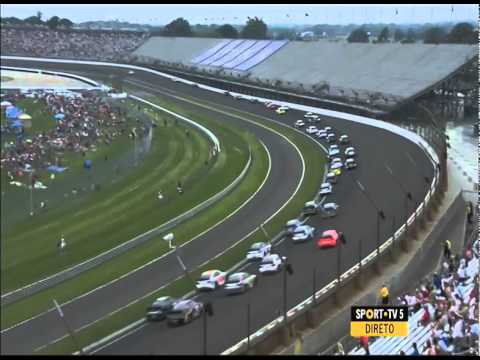Brickyard 400’s profit margin getting perilously thin for IMS
 |
| Why is NASCAR allowed to race at the hallowed grounds of IndyCar, yet it will be a cold day in hell before IndyCar is ever allowed to race at Daytona? |
I wrote an article for IBJ in 2003 about the Brickyard 400 that seems like a lifetime ago.
The headline was "Drafting off NASCAR."
The story detailed the financial prowess of the Indianapolis Motor Speedway's Brickyard 400, which debuted in 1994, and how then-Speedway boss Tony George used the money from the NASCAR race to prop up the Indy Racing League–now the IndyCar Series.
The story noted that the NASCAR race brought in about $35 million in annual revenue in those days and $25 million or more in profit–yes, profit–for the Speedway. Back then, motorsports business experts said the race brought in more than $20 million in ticket revenue alone and that over the first decade of the race, it netted the Speedway about $300 million in profit. Chicago-based motorsports business consultant Tim Frost called the race "the ultimate use of a fixed asset."
My, how things change. The Brickyard, according to IMS officials, is still profitable and is still a solid use of a fixed asset. But it's not as profitable as it used to be. Not even close.
And now the Speedway is hoping to use momentum from its IndyCar crown jewel–the Indianapolis 500–to somehow bolster the flagging Brickyard 400. The 100th running of the Indy 500 this May drew a huge crowd, and Speedway officials have been trying to convince spectators who saw that race at the Speedway that they should return to the track this weekend.
Attendance at the Brickyard 400 has plummeted from more than about 270,000 during its halcyon days to 75,000 in recent years. Not even the final NASCAR race here for Hoosier native Tony Stewart has drummed up much excitement this year. And 90-plus degree temperatures forecasted for the race this Sunday aren't going to help walk-up ticket sales. Semi-retired fan favorite Jeff Gordon will replace injured Dale Earnhardt Jr. on Sunday, the series announced this morning, so we'll see if that moves the needle.
In the meantime, business research firm WalletHub estimates ticket sales for this year's race will be $8.5 million. That might be optimistic. Either way, it's about one-third what it was at the Brickyard's high point.
While the Speedway does get money from a variety of sources–TV, sponsorship, parking and concessions–sports business experts estimate two-thirds of the Speedway's Brickyard 400 revenue comes from ticket sales. Costs for the race were estimated at $5 million to $10 million a decade ago–and you can assume they've been hit by inflation like everyone else. So you can see the IMS' revenue and expenses are getting perilously close on this event. If the weather scares away another 20 percent of so of the crowd, it could be trouble.
Speedway President Doug Boles told IBJ earlier this month that, despite the attendance declines, the Brickyard still "draws more people than most NFL stadiums." He said it's the third-biggest annual sporting event in the state, behind the Indianapolis 500 and Carb Day.
NASCAR does not release attendance figures, but Boles said the Brickyard 400 ranks between fourth and eighth out of NASCAR's 36 races each year.
Here's another perspective–and one that shows the IMS isn't the only one taking a hit by the race's decline.
WalletHub estimates the Brickyard 400 will have a $29 million economic impact on central Indiana. That economic impact falls below that of the city's five biggest conventions. It's not even half that of the city's two biggest conventions–GenCon, with a projected $71.8 million impact this year, and the Performance Racing Industry show, with a projected impact of $70.3 million.
Don't get me wrong, conventions are great business for this city, but a major sporting event shouldn't be smaller than a convention.
The Speedway has tried to bolster the race. This year it even built a dirt track on the infield as an homage to Stewart, who is retiring after this year. Boles has even talked about making dirt-track racing a permanent part of the Brickyard weekend.
The Speedway is spending 10 percent more on traditional marketing for the Brickyard than it did last year, Boles said. He said the marketing push is more focused than usual on southern Indiana, particularly Stewart's hometown of Columbus.
The Speedway has added concerts and the Xfinity Series race in recent years. Nothing, it seems, has generated much buzz.
By now, I've heard all the excuses for the race's decline. NASCAR popularity–and attendance–is down nationwide. It's simply too hot in late July in Indiana to sit outside in the middle of the afternoon to watch a race. The IMS is too flat, and there's little to no passing during the Brickyard. One motorsports insider this week even suggested that rude NASCAR officials have worn on fans and media members here in Indy over the years.
Boles points out that despite the reduction of seats over the last decade, the 235,000-seat IMS is the biggest NASCAR venue there is.
"Our challenge is, we're compared against our capacity," Boles said.
But the Brickyard's biggest challenge is that the race is compared to what it once was.
And it's a shell of its former self. Anthony Schoettle/IBJ.com
